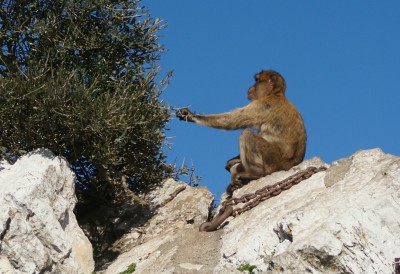
It was still pitch black when I got up. Not surprising, considering I was still in northern-ish Europe in November. But this was before four, even, meaning that I woke up around the same time as some of my roommates returned from the night out. Hauling my arse and my backpack to Victoria Station, I soon had upheld my part of the deal with Oasis: to be at Gatwick, baggage dropped and security checked, before the gate closed.
The flight to Gibraltar was uneventful, though longer than expected, until the time for descent. Gibraltar airport is considered one of the most difficult ones in the world. Only 1800 metres long, the runway is split in half by a traffic and pedestrian lane. The traffic is cut off when flights are about to land or take off, obvs, but still.
Soon the group that was going to be my family for the next week or ten converged.
Diverse in nationality, though not in gender, our male dominated pack clocked mostly in the 30-40 year span, with one or two exceptions on either side.
Parked a quick walk from the Gibraltarian border into the sunny Spain, was Nala, in all her yellowness. A Scania truck, converted into an overlanding vehicle, complete with cleverly hidden baggage space and complete camping and kitchen equipment, this was going to be our home for the next week or ten.
The first stop of the Western Africa adventure was therefore not Africa at all, but rather the British enclave of Gibraltar. A tax free paradise, the small town of some 30.000 citizens boasts fine shopping and nice eating at decent prices. Transport ships line up for the cheap fuel, and the marina is a popular stop for cruise ships and yachts entering or leaving the Mediterranean.
There’s also a rock. The rock, in fact. Strategically important, the British have held the rock for ages, despite several attempts from the Spaniards. During the great siege, the Spanish attempted to scale the north side of the rock, where they were relatively protected from assault. The solution? Digging a tunnel through the mountain, of course! Cannons were placed at various places, and the tunnelling kept on going even after the siege was over.
The rock itself has many natural cave systems, the biggest of which is St George’s cave. During the war, plans were made to use it as a hospital, but those were never put into play. Nowadays they use the spectacular stalactites and splendid stalagmites along with music and light shows to create concerts.
As the most iconic aspect of Gibraltar is The Rock, the most iconic aspect of The Rock is the monkeys. The only indigenous species of monkeys in mainland Europe, the rock apes (or barbary macaques, which is their real name, and a more fitting too; they’re not apes at all, but monkeys*) populate the higher-up parts of the cliff, and they are, even by monkey standard, incredibly clever and evil. They are known to break into hotel rooms and steal wallets and purses, they can open car doors and are completely unafraid of humans.
It is said that as long as there are monkeys on the rock, Gibraltar will remain British. Naturally, Churchill took heed, and imported more monkeys, made laws for protecting them, and demanded that they should be properly fed, which they still are to this day.
This day ended eventually, though. Early to bed was probably a good idea, as it was still pitch black when I got up. Not surprising, considering I was still in Europe in November, albeit the southernmost part. But it was time to take down the tents in the dark, and finally catch the ferry to Africa!
Teehee, I said butt monkey….

